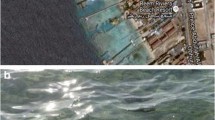Abstract
In an attempt to obtain biological control agents for controlling bacterial spot of cucumber, over 250 bacterial strains were isolated from agricultural soil samples, collected from different localities in Giza Governorate (Egypt) and screened forin vitro antibiosis towardsXanthomonas campestris. Only 2 strains showed antagonistic activity. They and their culture filtrates restricted the growth of a number of G− and G+-indicator bacteria. On Chrome Azurol S agar, both strains exhibited a marked siderophore production.Biolog plates identified these strains asRahnella aquatilis. Their characteristics were studied and compared with literature data onR. aquatilis. This antagonistic bacterium has not been previously isolated in Egypt.
Similar content being viewed by others
References
Alexander B.D., Zuberer D.A.: Use of Chrome Azurol S reagents to evaluate siderophore production by rhizosphere bacteria.Biol.Fertil.Soils12, 39–45 (1991).
Angerer A., Klupp B., Braun V.: Iron transport system ofSerratia marcescens.J.Bacteriol.174, 1378–1387 (1992).
Barthakur M.: Plant growth promotion and fungicidal activity in a siderophore-producing strain ofProteus sp.Folia Microbiol.45, 539–544 (2000).
Bell C.R., Dickie G.A., Chan J.W.Y.F.: Variable response of bacteria isolated from grapevine xylem to control grape crown gall disease in planta.Amer.J.Enol.Viticul.46, 499–508 (1995).
Berge O., Heulin T., Achuak W., Richard C., Bally R., Balandrean J.:Rahnella aquatilis, a nitrogen-fixing enteric bacterium associated with the rhizosphere of wheat and maize.Can.J.Microbiol.37, 195–203 (1991).
Blackburn P., Polak J., Gusik S.A., Rubing S.D.: Nisin composition for use as enhanced broad range bactericides.Internat.Pat.Appl.Publ. WO89112399 (1989).
Chang C.L., Jeong J., Shin J.H., Lee E.Y., Son H.C.:Rahnella aquatilis sepsis in an immunocompetent adult.J.Clin.Microbiol.37, 4161–4162 (1999).
Deka Boruah H.P., Dileep Kumar B.S.: Plant disease suppression and growth promotion by a fluorescentPseudomonas strain.Folia Microbiol.47, 137–144 (2002a).
Deka Boruah H.P., Dileep Kumar B.S.: Biological activity of secondary metabolites produced by a strain ofPseudomonas fluorescens.Folia Microbiol.47, 359–364 (2002b).
El-Hendawy H.H.: Biological studies on bacteria pathogenic to melons.MSc Thesis. Cairo University, Cairo 1983.
El-Hendawy H.H.: Water stress in cucumber cotyledons infected withXanthomonas campestris pv.cucurbitae.Folia Microbiol.44, 530–534 (1999).
Farmer J.J.: Other genera of the familyEnterobacteriaceae, pp. 506–516 in N.R. Krieg, J.G. Holt (Eds):Bergey’s Manual of Systematic Bacteriology, Vol. 1. Williams & Wilkins, Baltimore 1984.
Farmer J.J., Davis B.R., Hickman-Brenner F.W., McWhorter A., Huntley-Carter G.P., Asbury M.A., Riddle C., Wathen-Grady H.G., Elias G.C., Fanning R., Steigerwalt A.G., O’Hara C.M., Morris G.K., Smith P.B., Brenner D.J.: Biochemical identification of new species and biogroups ofEnterobacteriaceae isolated from clinical specimens.J.Clin.Microbiol.21, 46–76 (1985).
Gavini F., Ferragut C., Lefebvre B., Leclerc H.: Etude taxonomique d’enterobacteries appartenant ou apparentees au genreEnterobacter.Ann.Microbiol.127B, 317–335 (1976).
Hamze M., Mergaert J., Van Vuuren H.J.J., Gavini F., Beji A., Izard D., Kersters K.:Rahnella aquatilis, a potential contaminant in large beer breweries.Internat.J.Food Microbiol.31, 63–68 (1991).
Ishimaru C.A., Klos E.J., Brubaker R.R.: Multiple antibiotic production byErwinia herbicola.Phytopathology78, 746–750 (1988).
Izard D.M., Gavini F., Trinel P.A., Leclerc H.:Rahnella aquatilis, nouveau membre de la famille desEnterobacteriaceae.Ann.Microbiol.(Institut Pasteur)130A, 163–177 (1979).
Izard D.M., Gavini F., Trinel P.A., Leclerc H.: In list no. 7, Validation of the publication of new names and new combinations previously effectively published outside the IJSB.Internat.J.Syst.Bacteriol.31, 382–383 (1981).
Kalchayanand N., Hanilin N.B., Ray B.: Sublethal injury makes Gram-negative and resistant Gram-positive bacteria sensitive to the bacteriocins, pediocin ACH and nisin.Lett.Appl.Microbiol.15, 239–243 (1992).
Kilyong K., Jordan D., Krishnan H.B.:Rahnella aquatilis, a bacterium isolated from soybean rhizosphere, can solubilize hydroxy apatite.FEMS Microbiol.Lett.153, 273–277 (1997).
Lauková A., Mareková M.: Production of bacteriocins by different enterococcal isolates.Folia Microbiol.46, 49–52 (2001).
Lindberg A.M., Ljungh A., Ahrne S., Lofdahl S., Molin G.:Enterobacteriaceae found in high numbers in fish, minced meat and pasteurised milk or cream and the presence of toxin encoding genes.Internat.J.Food Microbiol.39, 11–17 (1998).
Matsuyama H., Sasaki R., Kawasaki K., Yumoto I.: Production of a novel exopolysaccharide byRahnella aquatilis.J.Biosci.Bioeng.87, 180–183 (1999).
Mew T.W., Ho W.C., Chu L.: Infectivity and survival of soft rot bacteria in Chinese cabbage.Phytopathology66, 1325–1327 (1976).
Meyer J.M., Geoffroy V.A., Baida N., Gardan L., Izard D., Lemanceau P., Achouak W., Palleroni N.J.: Siderophore typing, a powerful tool for the identification of fluorescent and non-fluorescent pseudomonads.Appl.Environ.Microbiol.68, 2745–2753 (2002).
Morovský M., Pristaš P., Javorský P.: Bacteriocins of ruminal bacteria.Folia Microbiol.46, 61–63 (2001).
Mossialos D., Meyer J.M., Budzikiewicz H., Wolff V., Koedam N., Baysse C., Anjaiah V., Cornelis P.: Quinolobactin, a new siderophore ofP. fluorescens ATCC 17400, the production of which is repressed by the cognate pyoverdine.Appl.Environ.Microbiol.66, 487–492 (2000).
Nomura M.: Colicins and related bacteriocins.Ann.Rev.Microbiol.21, 257–284 (1967).
O’Sullivan D.J., O’Gara F.: Traits of fluorescentPseudomonas spp. involved in suppression of plant root pathogen.Microbiol.Rev.56, 662–676 (1992).
Penyalver R., Lpez M.M.: Co-colonization of the rhizosphere by pathogenicAgrobacterium strains and non-pathogenic strains K 84 and K 1026, used for crown gall biocontrol.Appl.Environ.Microbiol.65, 1936–1940 (1999).
Penyalver R., Oger P., Lpez M.M., Forrand S.K.: Iron-binding compounds fromAgrobacterium rhizogenes K84 produces a hydroxamate siderophore.Appl.Environ.Microbiol.67, 654–664 (2001).
Richard C.: NouvellesEnterobactericeae rencontrees en bacteriologie medicale:Moellerella wisconsensis, Koserella trabulsii, Leclercia adecarboxylata, Escherichia fergusonii. Enterobacter asburiae, Rahnella aquatilis.Ann.Biol.Clin.47, 231–236 (1989).
Riley M.A., Wertz J.E.: Bacteriocins: evolution, ecology, and application.Ann.Rev.Microbiol.56, 117–137 (2002).
Schwyn B., Neilands J.B.: Universal chemical assay for the detection and determination of siderophores.Anal.Biochem.160, 47–56 (1987).
Srinivasan R., Sarkar S., Pramanik K.K., Kuila R.K., Misra A.K.: Isolation and characterization ofLactococcus species producing bacteriocin.Indian J.Dairy Sci.48, 596–602 (1995).
Stevens K.A., Sheldon B.W., Klapes N.A., Klaenhammer T.R.: Nisin treatment for inactivation ofSalmonella species and other Gram-negative bacteria.Appl.Environ.Microbiol.59, 3613–3615 (1991).
Tallgren A.H., Airaksinen U., Weissenberg R., Ojamo H., Kuusisto J., Leisola M., von Weissenberg R.: Exopolysaccharide producing bacteria from sugar beets.Appl.Environ.Microbiol.65, 862–864 (1999).
Vauterin L., Hoste B., Kdersters K., Swings J.: Reclassification ofXanthomonas.Internat.J.Syst.Bacteriol.45, 472–489 (1995).
Vidaver A.K., Mathys M.I., Thomas M.E., Schuster M.E.: Bacteriocins of the phytopathogensPseudomonas syringac, P. glycinea andP. phaseolicola.Can.J.Microbiol.18, 705–713 (1972).
Author information
Authors and Affiliations
Rights and permissions
About this article
Cite this article
Ei-Hendawy, H.H., Osman, M.E. & Sorour, N.M. Characterization of two antagonistic strains ofRahnella aquatilis isolated from soil in egypt. Folia Microbiol 48, 799–804 (2003). https://doi.org/10.1007/BF02931517
Received:
Revised:
Issue Date:
DOI: https://doi.org/10.1007/BF02931517




